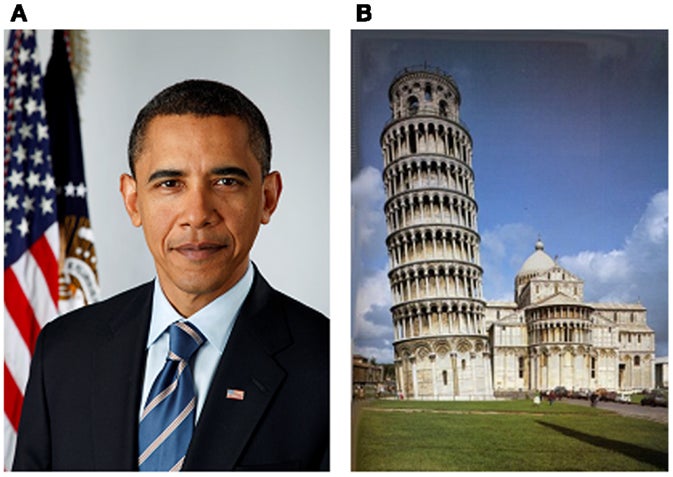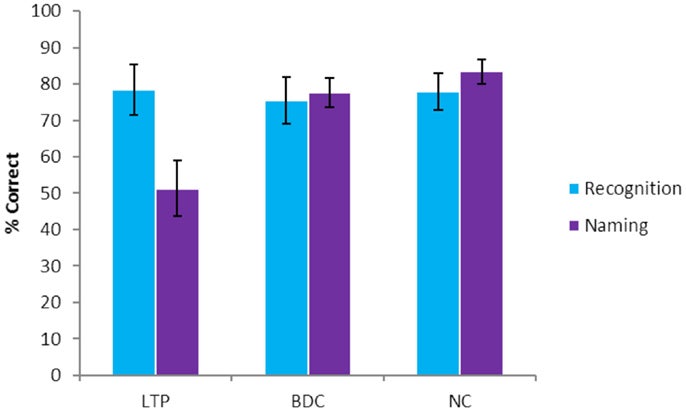This article was published in Scientific American’s former blog network and reflects the views of the author, not necessarily those of Scientific American
Proper nouns are names for unique persons, places, and things. One of these “things” can be songs. Songs have specific names, such as “Take Me Out to the Ballgame” or “Jingle Bells.” When you hear a song, you often think of its name. We conducted a scientific study to find out which parts of the brain are important for naming a famous song. We already had some clues about which brain region might be important – we knew from previous research that the left temporal pole (LTP) is an important brain region for naming proper nouns.
The Left Temporal Pole and Proper Naming
Have you ever seen a person and thought, “I know them! What is their name?” Imagine how frustrating it would be if you could not name people that you saw – even people that you knew very well. Previous research has identified a group of people who experience this on a daily basis. These people have brain damage to the LTP. The LTP is a region on the left side of the brain near the temples (see the colored region in Figure 2). Individuals with damage to the LTP have trouble naming unique items with proper names [1].
On supporting science journalism
If you're enjoying this article, consider supporting our award-winning journalism by subscribing. By purchasing a subscription you are helping to ensure the future of impactful stories about the discoveries and ideas shaping our world today.
Look at the picture in Figure 1A. If I asked you to name this face, you would probably say that this is Barack Obama. A person with damage to the LTP might say that this is the president of the United States, that he has two daughters, or that he was first elected in 2008. While knowing this information shows that they recognize the face, they would be unable to tell me his name. The difference between recognizing and naming is important: recognizing means that you know who the person is and other information about them (for example, he is the President of the United States). Naming means that you are able to give the proper name of the person (for example, Barack Obama).

Figure 1 - Examples of A) famous faces and B) landmarks.
Individuals with damage to the LTP are able to recognize famous faces, but cannot name them. This occurs with other unique items too. Individuals with LTP damage are impaired at naming famous people when they hear their voices [2]. They are also unable to name famous landmarks (Figure 1B), such as the Golden Gate Bridge and the Leaning Tower of Pisa [3]. Knowing this information, we wondered whether individuals with damage to the LTP would also have trouble naming famous musical songs. We predicted that musical songs are similar to faces and landmarks because they all have unique, proper names. Therefore, we predicted that patients with LTP damage would be impaired at naming famous songs.
Participants
The participants in our study were individuals who had brain damage to the LTP. These individuals have brain damage because they had brain surgery or strokes. In total, we studied 10 individuals with LTP damage. Figure 2 shows the exact area of brain damage in these patients. The “hotter” colors (red, orange) show the area, which is the LTP, where most patients have damage.

Figure 2 - Overlap map for patients with damage to the LTP.
The image on the left is a view of the brain from the left side. The images to the right (a–e) show slices of the brain through the LTP region. The color bar shows how many individuals have damage to this region, with the “hotter” colors (red, orange) representing higher numbers of individuals with damage.
In addition to the LTP group, we studied a group of individuals with brain damage outside the LTP. This is important because it can show if only damage to the LTP impairs naming of famous musical melodies, and not just damage anywhere in the brain. We call this group of individuals brain damaged comparisons (BDC). We studied 10 BDC individuals. Lastly, we studied 10 normal, healthy individuals with no brain damage. This group is called a normal comparison (NC) group. This way, we can see if individuals with damage to the LTP are impaired at naming famous musical melodies compared to people without any brain damage.
Naming Famous Songs
In order to see whether individuals with damage to the LTP had problems naming famous songs, we had participants listen to 52 famous musical songs. For example, this task included songs such as “Row Row Row Your Boat,” “The Star Spangled Banner,” and “Rudolph the Red Nosed Reindeer.” The songs that the participants heard did not have any words; they were just the notes of the tune. After hearing each song, participants rated how familiar they were with the song on a scale ranging from “completely familiar” (a 6 on the scale) to “completely unfamiliar” (a 1 on the scale). Then, they were asked to state the name of the song. If they could not state the name, they were asked to state the lyrics or continue humming/singing the tune of the song.
We found that participants in all three groups (LTP, BDC, NC) recognized most of the songs. To correctly recognize a song, a participant had to either: (1) name the song, (2) state the lyrics, (3) continue humming/singing the tune, or (4) rate the song as a 5 or 6 on the familiarity scale. In all three groups, participants correctly recognized about 80% of the songs (Figure 3). There were no differences between the three groups, which show us that the individuals with damage to the LTP group were not impaired at recognizing famous songs.

Figure 3 - Percent correct for naming and recognizing famous musical melodies.
Here, we show the scores for the three groups on both recognition (blue bars) and naming (purple bars) of famous musical melodies. This shows that all individuals, on average, recognized around 80% of the melodies. However, for naming the melodies, the BDC and NC groups correctly named about 80% of the melodies, while the LTP group named only 50% of the melodies. This shows us that individuals with LTP damage were impaired at naming famous melodies.
By contrast, when asked to name the song, individuals with damage to the LTP were significantly worse than individuals in the BDC and NC groups. Individuals in the BDC and NC groups correctly named about 80% of the songs, while individuals in the LTP group only correctly named about 50% of the songs (Figure 3).
Conclusion
Our findings support our prediction that individuals with damage to the LTP would be able to recognize famous musical songs, but not name them. These findings help show that the LTP is a critical region for naming proper nouns of various types, including famous faces, landmarks, and now, songs. Without this brain region, people are impaired at naming unique items. This shows us that the LTP is an important brain region for naming proper items. The LTP is called a “convergence zone” for naming items. What this means is that the LTP does not store the names of the items, but it is a region where the names of items are related to the information about the items. This explains why people with LTP damage are able to say information about the item but not the name. So, next time you hear a song on the radio and think of its name, remember that you are using your LTP!
Original Source Article
↑ Belfi, A. M., and Tranel, D. 2014. Impaired naming of famous musical melodies is associated with left temporal polar damage. Neuropsychology, 28:429–435.
References
[1] ↑ Damasio, H., Grabowski, T. J., Tranel, D., Hichwa, R. D., and Damasio, A. R. 1996. A neural basis for lexical retrieval. Nature 380:499–505. doi: 10.1038/380499a0
[2] ↑ Waldron, E. J., Manzel, K., Tranel, D. 2014. The left temporal pole is a heteromodal hub for retrieving proper names. Front Biosci (Schol Ed) 6:50–7. doi: 10.2741/S413
[3] ↑ Tranel, D. 2006. Impaired naming of unique landmarks is associated with left temporal polar damage. Neuropsychology 20(1):1–10. doi: 10.1037/0894-4105.20.1.1
Reviewed by
.jpg?w=150)
I love science and sports. I play baseball and learning kung-fu. I love to do experiments to understand how science works. In the science – I enjoy space/astronomy and physics. I enjoy reading a lot – and hope to write lot of kids’ books (I have started on three already). In my life, I want to invent something new and bring back to life something that is extinct – using DNA research.
You can find the original article highlighted here - or many others like it - published at Frontiers for Young Minds. (Belfi A and Tranel D (2015) Name that tune: What parts of our brains do we use for naming songs?. Front Young Minds. 3:6. doi: 10.3389/frym.2015.00006)